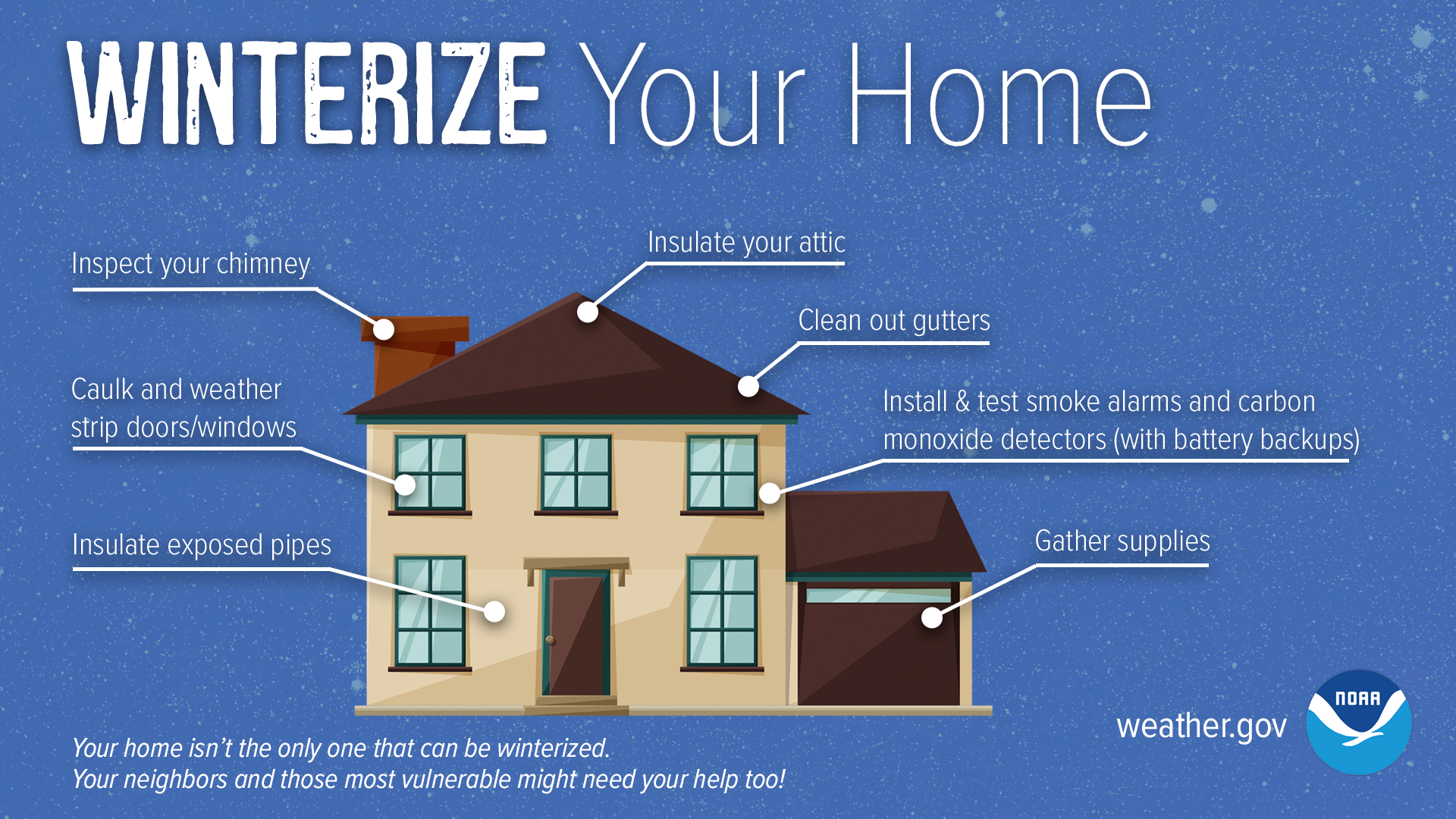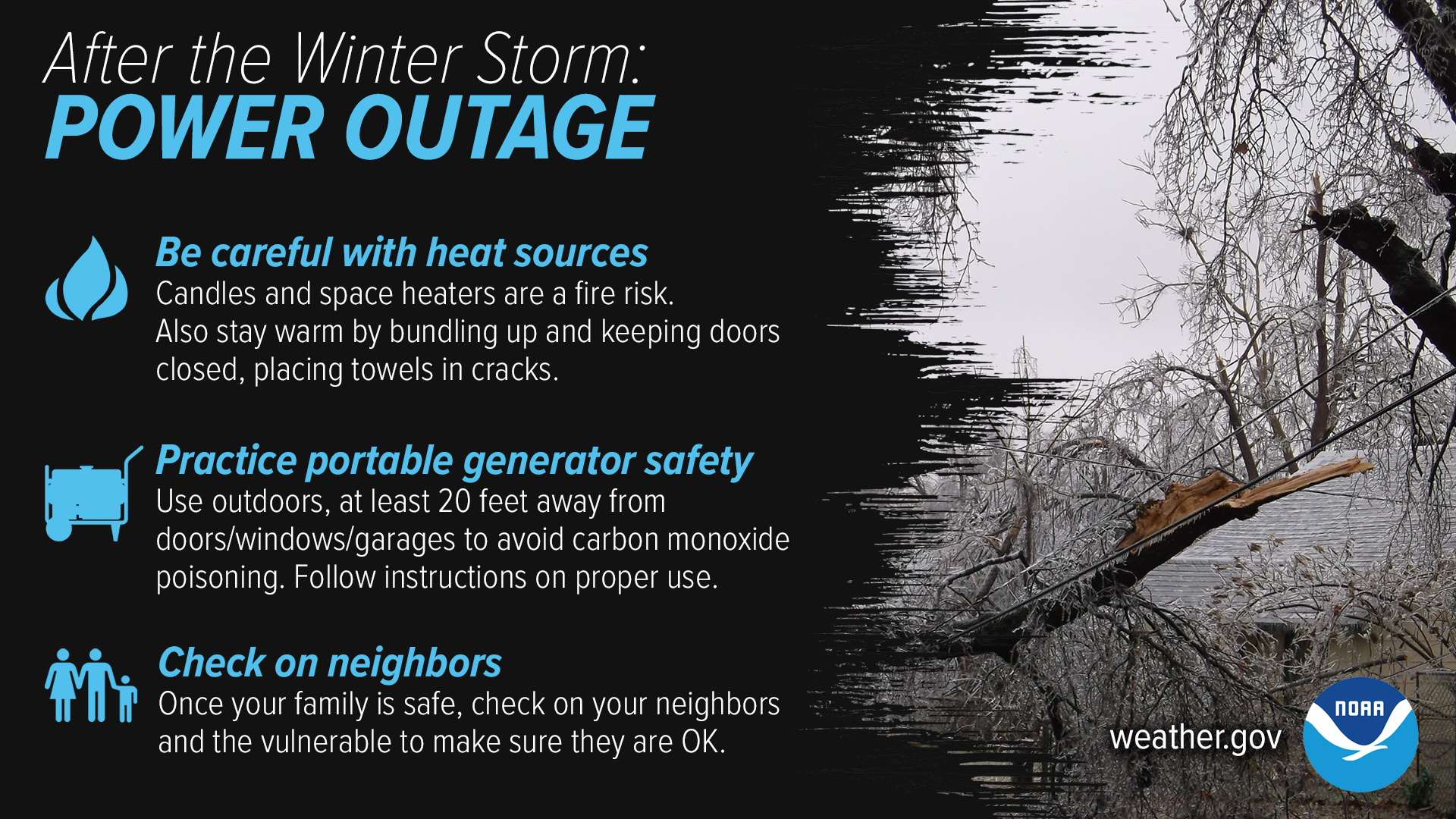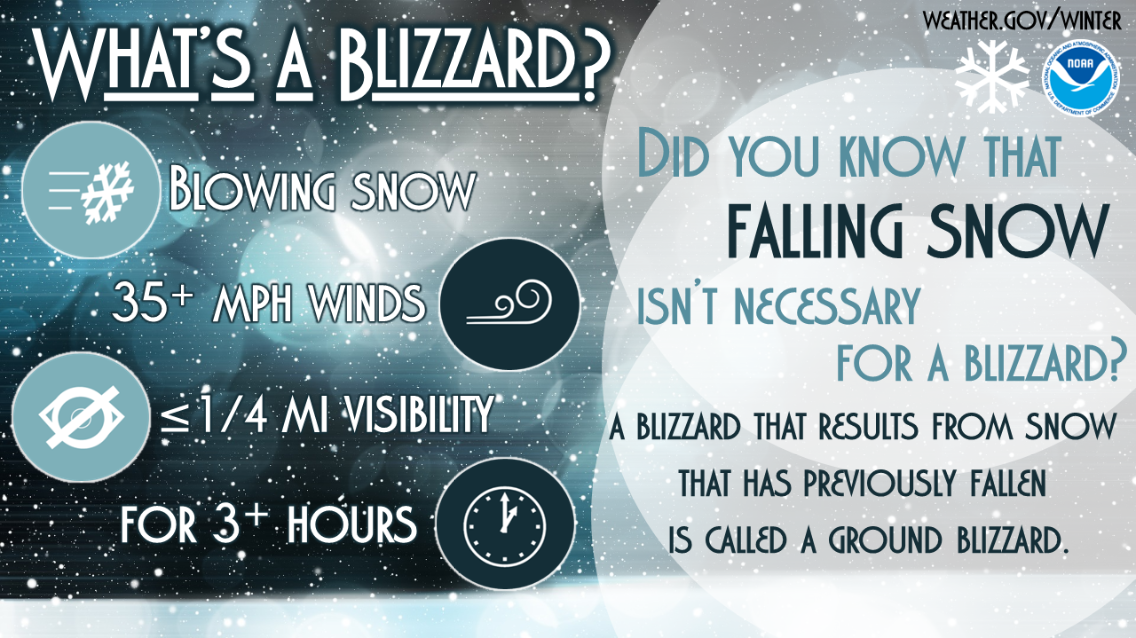Please help the National Weather Service spread these important safety messages on social media! Everyone is welcome to use the text and images provided below to help the NWS build a Weather-Ready Nation.
Facebook
As winter approaches, there are steps you can take to prepare your home for the cold weather ahead. Learn more at weather.gov/safety/winter
Twitter
As winter approaches, there are steps you can take to prepare your home for the cold weather ahead. Learn more at weather.gov/safety/winter

Facebook
Power outages are common after a big winter storm. If you lose power, make sure to be careful when using alternative heat sources and practice portable generator safety. Once you and your family are safe, check in with others in your neighborhood to make sure they are okay. weather.gov/safety/winter
Twitter
Power outages are common after a big winter storm. Be careful with alternative heat sources, practice portable generator safety, and check in with neighbors to ensure that everyone stays safe. weather.gov/safety/winter

Facebook
Did you know that a one or two degree temperature difference can play an important role in whether we get rain, sleet, or snow? Learn more about how we get accurate forecasts here: youtube.com/watch?v=niPqFAtq8_E
Twitter
Did you know that a one or two degree temperature difference can play an important role in whether we get rain, sleet, or snow? Learn more about how we get accurate forecasts here: youtube.com/watch?v=niPqFAtq8_E
Facebook
Impacts from winter storms can vary a lot, even across short distances, and it can be difficult to pinpoint exactly which areas will be most impacted. Learn more about the Winter Storm Severity Index here: youtube.com/watch?v=u_rLZicceTc
Twitter
Impacts from winter storms can vary a lot, even across short distances, and it can be difficult to pinpoint exactly which areas will be most impacted. Learn more about the Winter Storm Severity Index here: youtube.com/watch?v=u_rLZicceTc
Facebook
We work hard to provide you with the most accurate forecasts possible, and our forecasts get more precise the closer we get to a big weather event. Learn more about how we update our forecasts at youtube.com/watch?v=O19o47qWdSE
Twitter
We work hard to provide you with the most accurate forecasts possible, and our forecasts get more precise the closer we get to a big weather event. Learn more about how we update our forecasts at youtube.com/watch?v=O19o47qWdSE
Facebook
A Wind Chill WATCH means Be Prepared.
A Wind Chill WARNING means Take Action!
weather.gov/safety/cold
Twitter
A Wind Chill WATCH means Be Prepared.
A Wind Chill WARNING means Take Action!
weather.gov/safety/cold

Facebook
Is your home ready for an ice storm? Ice storms can cause power outages that can last up to several days, affecting both you and the surrounding area — that’s why it’s important to have a week’s supply of food and prescriptions. What else would you need?
Ice storms can easily break tree branches, so trim weak or damaged branches around your home, and don’t park your car under trees. After you’ve parked, don’t leave your wipers raised...contrary to popular belief, doing so increases the chance of wiper damage.
Learn more about ice storm safety: weather.gov/safety/winter-ice-frost
Twitter
Is your home ready for an ice storm? Ice storms can cause power outages that can last several days and pose a threat to tree branches and anything underneath. Stay #WeatherReady and learn more about ice storm safety: weather.gov/safety/winter-ice-frost

Facebook
When the power goes out in winter, the cold can be deadly--but even without power, there are still ways to warm things up. Closing blinds and curtains and closing room doors can help contain heat, and stuffing towels in the cracks under doors can help keep the warmth in. Don’t forget about eating and staying hydrated - food provides energy to warm the body.
Learn more about winter safety: weather.gov/safety/winter
Twitter
When the power goes out in winter, the cold can be deadly. But even without power, there are still ways to warm things up. Stay #WeatherReady and learn more about winter safety: weather.gov/safety/winter

Facebook
Don't forget about your pets this winter! Make sure they have a warm, dry place to rest with plenty of food and water. weather.gov/winter
Twitter
You love your pets, so keep them warm, dry, and well fed this winter. weather.gov/winter #WeatherReady

Facebook
Slippery sidewalks and roads aren’t the only things to look out for in late winter and early spring snow storms--shoveling snow can be a health risk as well. Remember to stay hydrated, take frequent breaks, and move only small amounts with each shovel pass. Learn more at weather.gov/winter
Twitter
Shoveling snow can be a health risk, so remember to take it easy. Learn more at weather.gov/winter #WeatherReady

Facebook
Ice is never completely safe. Know how thick the ice is and stay away from any cracks or melting ice. If you don’t know, don’t go! weather.gov/safety/winter
Twitter
Ice is never completely safe. Know how thick the ice is and stay away from any cracks or melting ice. If you don’t know, don’t go! weather.gov/safety/winter #WeatherReady

Facebook
Bundling up and staying dry are two of the best things you can do to stay safe from cold temperatures this fall and winter. Wear layers to stay warm and continue to follow CDC guidelines on how to protect yourself and stop the spread of COVID-19, including wearing a mask. Learn to protect yourself from the cold at weather.gov/safety/cold
Twitter
Bundling up and staying dry are two of the best things you can do to stay safe from cold temps. Wear layers to stay warm and continue to follow CDC guidelines on how to protect yourself and stop the spread of COVID-19, including wearing a mask weather.gov/safety/cold

Facebook
If you notice someone exhibiting warning signs of hypothermia, get them to a warm place right away. Learn more about how to protect yourself from the cold at weather.gov/safety/cold
Twitter
Do you know the signs of hypothermia? weather.gov/safety/cold #WeatherReady

Facebook
Cold weather can be life-threatening. If you can’t avoid being outside, remember to follow these 3 steps and make sure to always tell someone where you’re going. weather.gov/safety/cold
Twitter
Cold weather can be life-threatening, so follow these 3 steps and make sure to always tell someone where you’re going. weather.gov/safety/cold #WeatherReady

Facebook
Extremely cold air affects millions of people across the United States every winter and even into parts of the spring. This Arctic air, together with brisk winds, can lead to dangerously cold wind chill values, which can cause your body to lose heat quickly. weather.gov/safety/cold-wind-chill-chart
Twitter
Arctic air, together with brisk winds, can lead to dangerously cold wind chill values. weather.gov/safety/cold-wind-chill-chart

Facebook
Did you know not all blizzards involve falling snow? By definition, a blizzard includes 35+ mph winds that cause blowing snow, reducing visibility to 1/4 mile or less for at least 3 hours. If the visibility reduction comes from snow that has already fallen, it is called a ground blizzard. Whether or not the snow falls during the time of the blizzard, dangerous conditions can result. Make sure you’re prepared! weather.gov/winter
Twitter
Did you know that not all blizzards involve falling snow? Whether or not the snow falls during the blizzard, dangerous conditions can result. weather.gov/winter Be #WeatherReady!

Facebook
Not many winter storms have the potential to bury 100 million people in 1-2 feet of snow in a single day. Nor’easters are notorious for packing strong winds and copious amounts of moisture they get from the Atlantic. The heavily-populated region between Washington D.C., Philadelphia, New York City, and Boston -- the “I-95 Corridor” -- is especially impacted by Nor’easters. weather.gov/safety/winter-noreaster
Twitter
Nor’easters are notorious for big wind and copious amounts of moisture they get from the Atlantic. weather.gov/safety/winter-noreaster #WeatherReady

Facebook
Will there be rain, ice, or snow? This graphic explains how having different layers of warm and cold air between the clouds and the ground determines the type of precipitation that hits the ground. nssl.noaa.gov/education/svrwx101/winter/types/
Twitter
Will there be rain, ice, or snow? Find out how wintry precipitation forms! nssl.noaa.gov/education/svrwx101/winter/types/

Facebook
Frost can be annoying to scrape off your car, but did you ever think about how it got there? Watch this video for a little frost science: youtu.be/HBn1oSWu2nE
Twitter
Frost can be annoying to scrape off your car, but did you ever think about how it got there? Watch this video for a little frost science: youtu.be/HBn1oSWu2nE
Facebook
Nor’easters impact millions of people in the eastern U.S. with heavy snow and strong winds. What will you do if one approaches your region? weather.gov/safety/winter-noreaster
Twitter
Nor’easters impact millions in the eastern U.S. with heavy #snow and strong winds. Are you prepared? weather.gov/safety/winter-noreaster #WeatherReady
